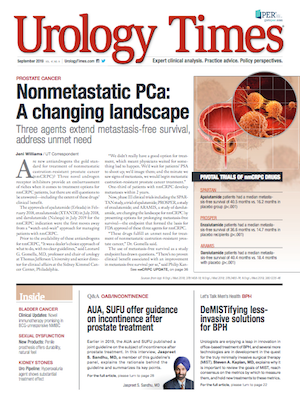Publication
Article
Urology Times Journal
PSMA PET/CT beneficial for prostate cancer staging
Author(s):
A new study suggests that prostate-specific membrane antigen positron emission tomography/computed tomography may be a highly beneficial tool for initial staging of high-risk and high-intermediate-risk prostate cancer.
A new study suggests that prostate-specific membrane antigen positron emission tomography/computed tomography (PSMA PET/CT) may be a highly beneficial tool for initial staging of high-risk and high-intermediate-risk prostate cancer.
At the AUA annual meeting in Chicago, researchers reported that by adopting this imaging approach, it may be possible to alter treatment plans and provide more precise and appropriate interventions to avoid treatment failure. The authors found that judicious use of PSMA PET/CT can rule in or rule out lesions suspicious on conventional imaging.
“This is a huge advance. After pathology confirmation, I think the standard of care will be changed and this approach will be adopted. It is already adopted in a lot of places. Europe and Australia are ahead of us in this area,” said study investigator Aydin Pooli, MD, a urologic oncology fellow and clinical instructor in urology at the David Geffen School of Medicine at UCLA, working with Robert E. Reiter, MD, and co-authors.
Read: PET use in prostate cancer widens, but questions remain
PSMA is a transmembrane glycoprotein that is primarily expressed in prostate tissue, and it can be radiolabeled with gallium 68 and used as a tracer in nuclear scan imaging. It has been demonstrated that PSMA is highly sensitive for detecting metastasis. Dr. Pooli and his colleagues investigated the concordance of PSMA PET/CT with conventional imaging in the initial staging in treatment-naïve men with prostate cancer. They conducted a prospective, single-institution database study of patients undergoing PSMA PET/CT from 2016 to 2018 (NCT03368547).
The authors included men with intermediate-risk (Gleason score 7 and/or PSA 10-20 ng/mL) and high-intermediate-risk disease (Gleason score ≥8 and/or PSA >20 ng/mL) who underwent PSMA PET/CT within 3 months of conventional imaging (bone scan and/or abdominopelvic imaging). They analyzed the concordance of PSMA PET/CT with conventional imaging for the identification of N+ (pelvic lymph node), M1a+ (extrapelvic lymph nodes), M1b+ (bone metastases), and M1c+ (visceral metastasis) disease. They also examined the association between PSA level and concordance of conventional imaging and PSMA PET/CT.
Next: PET/CT identifies up to 16.5% more diseasePET/CT identifies up to 16.5% more disease
The current analysis included 182 patients (mean age, 65.5 years), and 72% had high-risk disease. Among these patients, the median PSA was 11.4 (6.8-24.1) ng/mL. The authors found the rate of non-concordance between PSMA PET/CT and conventional imaging was 22.2% for N+, 9.7% for M1a+, 16.9% for M1b+, and 1% for M1c+ disease. Dr. Pooli said PSMA PET/CT identified between 8% and 16.5% more disease and it potentially ruled out between 1.7% and 11.5% of disease.
“Conventional imaging is picking up some stuff that is not metastasis, but suspicious lesions. That can lead to biopsy, but PSMA can actually stage these,” Dr. Pooli said in an interview with Urology Times.
Also see: Neoadjuvant chemohormonal therapy efficacious for high-risk PCa
He said the guidelines for primary staging of prostate cancer recommend abdominopelvic cross-sectional imaging and a bone scan for high-risk and high-intermediate-risk disease and cross-sectional imaging for intermediate-risk disease with high enough suspicion for metastasis. However, Dr. Pooli said the sensitivity and specificity of those imaging techniques are relatively low.
PSMA detected metastatic pelvic lymph nodes in 51 patients compared to 32 patients receiving conventional imaging. It also detected extrapelvic lymph nodes in 16 patients compared to five receiving conventional imaging. It detected bone metastasis in 17 patients compared to 22 patients receiving conventional imaging. Dr. Pooli said in terms of pelvic lymph nodes, PSMA detected 29 patients with metastasis that were missed on conventional imaging and did not confirm suspicious lesions in 10 patients.
Dr. Pooli said this is the largest cohort of patients with PSMA PET/CT for initial staging of prostate cancer and if validated in future investigations, it could lead to improved care.
“This can be a one-stop shop for these patients,” said Dr. Pooli. “We can get a whole-body scan, which is very sensitive for prostate cancer. It could be cost-effective.”





























